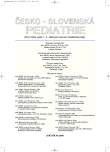Primary Disorders of Lipid Metabolism in Children – Our Experience
Primární poruchy metabolismu lipidů u dětí – naše zkušenosti
Úvod:
V letech 1996–2005 bylo vyšetřeno v ambulanci pro poruchy metabolismu lipidů kliniky 697 dětí (350 chlapců, 347 dívek) odeslaných praktickými lékaři pro děti a dorost pro dyslipoproteinémii (DLP).
Materiál a metody:
U pacientů byly sledovány hodnoty celkového cholesterolu (TC), LDL, HDL, triacylglycerolů (TAG). Diagnóza primární DLP byla molekulárně-geneticky potvrzena u 59 dětí (27 chlapců, 32 dívek). Familiární hypercholesterolémie byla prokázána u 12 pacientů (5 chlapců, 7 dívek) průměrného věku 14,7 roků. Mutace R395W, D461N, G571E a D245E byly nejčastější. Familiární defekt apolipoproteinu B-100 byl prokázán u 47 dětí (22 chlapců, 25 dívek) průměrného věku 14,5 roků. Byly porovnávány vstupní hodnoty TC, HDL, LDL, TAG s hodnotami po 6měsíčním dodržování diety.
Výsledky:
Z provedeného statistického testování vyplynulo, že hladiny TC u dětí po dietní léčbě významně klesly ve srovnání s hladinami výchozími, pokles činil cca 13 %. Statisticky významný byl rovněž pokles hladin LDL se stavem před dietou v průměru o 12 %. U 8 dětí léčených kromě diety i hypolipidemiky (Sortis, Questran) byly srovnávány hodnoty TC, TAG, HDL, LDL před léčbou, na dietě a po 6měsíční kombinované léčbě. Statistickým testováním bylo prokázáno, že kombinovaná léčba podstatným způsobem snížila hladiny sérového TC, pokles činil více než 55 %. Kombinovaná léčba vedla rovněž ke statisticky signifikantnímu snížení hladin sérového LDL (p <0,05). Snížení se pohybovalo okolo 57 %.
Závěr:
U většiny dětí s DLP stačí pouze úprava výživových a pohybových zvyklostí k normalizaci koncentrací lipidů. Děti si tyto návyky zafixují a ponesou do své “ rizikové” dospělosti. Indikace k zahájení farmakologické je přísně individuální a vyžaduje sledování specialistou.
Klíčová slova:
děti, familiární hypercholesterolémie, familiární defekt apolipoproteinu B-100, hypolipidemická léčba, prevence
Authors:
L. Dostalová Kopečná
Authors‘ workplace:
I. dětská interní klinika LF MU a FN Brno
přednostka prof. MUDr. H. Hrstková, CSc.
Published in:
Čes-slov Pediat 2006; 61 (9): 506-512.
Category:
Original Papers
Overview
Introduction:
In the years 1996–2005 authors have examined in their our outpatient department 697 children (350 boys and 347 girls) sent to them in relation of dyslipoproteinemia (DLP) by general practitioners for children and adolescents.
Materials and methods:
In these patients were followed total cholesterol (TC), LDL, HDL, and triacylglycerols (TAG). The diagnosis of primary DLP was confirmed by molecular genetic methods in 59 children (27 boys, 32 girls). Familial hypercholesterolemia was demonstrated in 12 patients (5 boys and 7 girls) at the average age of 14.7 years. The mutations R395W, D461N, G571E and D245E proved to be most frequent. Familial defect of apolipoprotein B-100 was demonstrated in 47 children (22 boys, 25 girls) with values after 6 months of adhering to the diet.
Results:
The statistical analysis revealed that the levels of TC in children after dietary treatment decreased significantly in comparison with the starting values, the decrease being 13%. The decrease of LDL levels was also statistically significant, reaching values 12% lower than the starting ones. In 8 children treated by diet and also by hypolipidemic drugs (Sortis, Questran), their TC, TAG, HDL, and LDL levels before the therapy, on the diet and after 6 months of combined treatment were compared. Statistical analysis demonstrated that the combined therapy significantly decreased the levels of serum TC by more than 55%. The combined therapy also resulted in a statistically significant decreased in the levels of serum LDL (p <0.05). The decrease was by about 57%.
Conclusions:
In most children with DLP the adjustment of nutritional and physical habits is sufficient to return the lipid concentrations to normal levels. Children often maintain their unfavorable habits and carry out such risk into adulthood. Indications for initiation of pharmacological therapy are strictly individual and require observation by a specialist.
Key words:
children, familial hypercholesterolemia, familial defect of apolipoprotein B-100, hypolipidemic therapy, prevention
Labels
Neonatology Paediatrics General practitioner for children and adolescentsArticle was published in
Czech-Slovak Pediatrics

2006 Issue 9
- What Effect Can Be Expected from Limosilactobacillus reuteri in Mucositis and Peri-Implantitis?
- The Importance of Limosilactobacillus reuteri in Administration to Diabetics with Gingivitis
Most read in this issue
- Primary Disorders of Lipid Metabolism in Children – Our Experience
- Does Artificial Suckling Nutrition Pose a Risk of Atherosclerosis at the Adult Age?
- Food Supplements with Fish Oils – The Composition of Fatty Acids
- National Cholesterol Program in Children’s Population in Slovakia and Its Contribution
